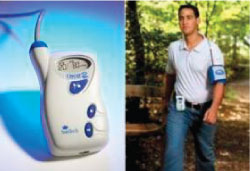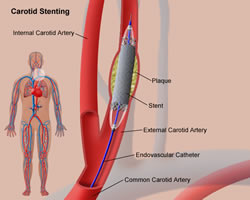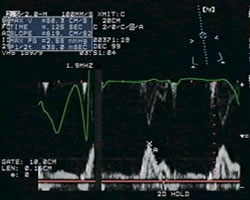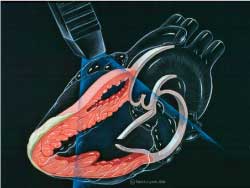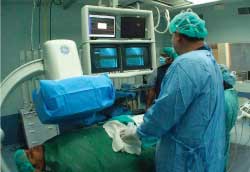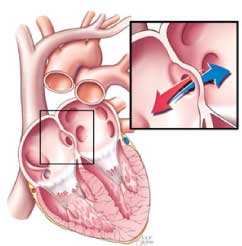Peripheral Vascular Intervention (WAS Peripheral Vascular Intervention)
- PERIPHERAL ANGIOPLASTY –A procedure for opening narrowed arteries to the upper and lower limbs (legs).
- RENAL ANGIOGRAM | ANGIOPLASTY
- PERIPHERAL ANGIOGRAM | ANGIOPLASTY
- CAROTID ANGIOGRAM | ANGIOPLASTY –A procedure to open arteries in the neck that supply the brain and to prevent strokes… read more
- ENDOVASCULAR AORTIC REPAIR (EVAR) –Thoracic and abdominal aneurysms / dissection repair.
- HAEMODIALYSIS ACCESS AND MANAGEMENT –A procedure to cleanse the blood in patients with abnormal kidney function.
- FISTULOGRAM/FISTULOPLASTY –A procedure to diagnose and clear/open narrowing fistula implants.
- HYBRID (SURGERY & INTERVENTION)
- INFERIOR VENA CAVA FILTER INSERTION
- UTERINE FIBROID EMBOLIZATION (ELECTIVE)
Interventional Neuro-Radiology/Radiology
- CEREBRAL ANGIOGRAM –A procedure used to detect brain aneurysms or other brain abnormalities.
- CEREBRAL EMBOLIZATION (COILING) & STENTING –A procedure for the closure of an aneurysm (dilatation) or a vascular malfunction in the arteries of the brain.
- BILLARY DRAINAGE AND STENTING
- TUMOR EMBOLIZATION -(Kidney, Pelvis, Spleen, Liver, Craniofacial, Etc)
- UTERINE FIBROID EMOLISATION (UFE)
- CHEMOEMBOLIZATION
- CT GUIDED NEEDLE BIOPSY
- ABSCESS DRAINAGE AND DRAIN INSERTION
- PERCUTANEOUS NEPHROSTOMY
- DIALYSIS ACCESS INTERVENTIONS
- ENDOVENOUS RADIOFREQUENCY TREATMENT OF VARICOSE VEINS
- VARICOCELE EMBOLIZATION
Electrophysiology Services ((EP) Electrical Activity of the Heart/Ablation etc.)
- PERMANENT PACEMAKER AND TEMPORARY PACEMAKER (ELECTIVE & EMERGENCY) –Small devices placed under the skin of the chest or abdomen to help monitor and control abnormal rhythms (irregular heartbeat)…Read more
- DIAGNOSTIC & THERAPEUTIC RADIOFREQUENCY ABLATION –Treatment of fast/irregular heart rates.
- INTRACARDIAC DEFIBRILLATOR (ICD) IMPLANTATION
- CARDIAC RESYNCHRONISATION THERAPY –BI Ventricular Pacemakers and CRT-D insertion.
- Coronary Artery Bypass Graft
Oxygen is supplied to the heart muscle by the right and the left coronary arteries. These two main arteries further subdivide supplying blood with oxygen to the heart muscle.When these arteries get totally or partially blocked the heart muscle gets insufficient oxygen to perform its work. This initially results in chest pain or angina. If left untreated the heart muscle will actually die. This is called a myocardial infarction or heart attack. With surgical correction a bypass graft is done. That is, a conduit is taken either from the chest or the leg and used to bypass the coronary artery at the point of the blockage
The heart acts like a pump, it generates a pressure, which enables it to pump blood through the lungs and then to the rest of the body. In order to do this the blood must flow only in one direction. The heart accomplishes this because of four one-way valves present inside the heart, which open and close in synergy with each pump of the heart, thereby allowing blood to flow in one direction. If these valves become defective,which could occur as after a valve infection or a heart attack involving the valve, they either become stiff and cannot open which is called stenosis or they may become too flaccid to close which is called incompetence or it may be a combination of both these conditions. When this occurs the pump is unable to generate enough pressure to pump blood throughout the lungs and around the body. During surgery the valve is either repaired or replaced.
- Valve Replacement or Repair
The heart acts like a pump, it generates a pressure, which enables it to pump blood through the lungs and then to the rest of the body. In order to do this the blood must flow only in one direction. The heart accomplishes this because of four one-way valves present inside the heart, which open and close in synergy with each pump of the heart, thereby allowing blood to flow in one direction. If these valves become defective,which could occur as after a valve infection or a heart attack involving the valve, they either become stiff and cannot open which is called stenosis or they may become too flaccid to close which is called incompetence or it may be a combination of both these conditions. When this occurs the pump is unable to generate enough pressure to pump blood throughout the lungs and around the body. During surgery the valve is either repaired or replaced.
- Thoracic Aortic Surgery
The aorta is the main pipe that takes blood from the heart and directs it to the rest of the body. Sometimes because of hypertension or a genetic disorder the aorta can actually blow up somewhat like a balloon. This ballooning of the aorta is called an aortic aneurysm, which can eventually rupture causing sudden death. Depending on the location of the aneurysm on the aorta it can be repaired with a tube graft at surgery or it can be reinforced by placing a stent in the area of the aneurysm. Sometimes due to high pressure or an accident the aortic wall itself may start splitting. This is called a dissecting aorta and depending on its location results in a medical emergency. A dissecting aorta can be repaired by a cardiologist performing a tube graft or stenting in the area of the dissection.
- Aortic Dissection / Aneurysm Repair
- An Aortic dissection is a serious condition in which the inner layer of the aorta, the large blood vessel branching off the heart, tears. Blood surges through the tear, causing the inner and middle layers of the aorta to separate(dissect). If the blood-filled channel ruptures through the outside aortic wall, aortic dissection is often fatal.
- An Aortic Aneurysm is an abnormal bulge that occurs in the wall of the major blood vessel (aorta) that carries blood from your heart to your body. Aortic aneurysms can occur anywhere in your aorta and may be tube-shaped (fusiform) or round(saccular)Both conditions are treated via surgery
- PEDIATRIC CONGENITAL & ADULT CONGENITAL HEART SURGERY
Sometimes patients are born with heart defects. This is called congenital heart disease. There are a multiplicity of congenital heart defects some of which have to be repaired surgically as an emergency, as in transposition of the great vessels, or electively as in atrial septal defects. On some occasions patients with congenital heart disease survive to adulthood before the defect in the heart becomes clinically significant. Depending on the defect, correction could be achieved by either surgery or with Interventional Cardiology.
-
- CORONARY ( AORTIC, RENAL, PERIPHERAL ) ANGIOGRAMS, INCLUDING PAEDIATRIC CASES –A procedure during which an interventional cardiologist injects a dye via a special catheter into your coronary arteries in order to obtain x-ray images of the blood circulation within the heart.
- CORONARY ( AORTIC, RENAL, PERIPHERAL ) ANGIOPLASTY AND STENTING –A procedure to open blocked or narrowed arteries using a balloon, after which a small mesh tube called a stent is inserted into the open artery.
- FIBROID EMBOLIZATION –A non-surgical invasive procedure to destroy fibroids in the uterus.
- NEURORADIOLOGICAL PROCEDURES –These are Cath Lab procedures that are alternatives to brain surgery such as Cerebral Aneurysm Coiling and/or Stenting and repair of AV malformation. Cerebral Aneurysm Coiling and/or Stenting is a procedure for the closure of an aneurysm (dilatation) or vascular malformation in the arteries of the brain and repair of AV malformation.
- PAEDIATRIC CATHETERIZATIONS –Right Heart Catheterization, Congenital Heart Disease plus Closure of Heart Defects (ASD, VSD, PFO)
- ELECTROPHYSIOLOGY SERVICES
- Vascular Services
- VALVE VALVULOPLASTY –A procedure to repair narrowed heart valves (stenotic).
- RENAL ABLATION –A procedure for the treatment of patients with severe hypertension by ablating the kidney arteries.
- GENERAL CARDIOLOGY CLINIC:Including treatment of coronary artery disease, Hypertension, heart failure and other cardiac pathologies.
- CARDIAC SURGERY CLINIC:Our cardiothoracic surgeons diagnose and treat, Patients in need of bypass or valve surgery.
- ARRHYTHMIA/ELECTROPHYSIOLOGY (EP) CLINIC:Treatment to patients with irregular, slow or fast heart rates, dizziness, fainting.
- VASCULAR CLINIC:Patients with peripheral artery disease, nonsurgical treatment of diabetic feet.
- ANTI-COAGULATION CLINIC:Drug treatment to regulate the clotting process in the blood.
- ECHO CLINIC :This clinic, which is unique to the Caribbean, is done by Cardiologists specialised in Echocardiography who can perform 3D ECHOs, Exercise and Pharmacological Stress ECHOs and TEEs. They also assist in diagnosis and screening of valve and congenital heart disease.
This department was founded in 2012 and since then has received several grants from patients and institutions, which have been dedicated to research and education on Cardiovascular disease. Several articles have also been published in peer reviewed and indexed journals.
Several local and foreign consultants participate in this Research and Developmentinitiative assisted by two directors: Professor Gianni D.Angelini and Dr. Risshi D. Rampersad.
- Transfusion related acute lung injury with massive pulmonary secretion during Cardiac surgery. A case report. Teodori J., Rampersad K., Teodori G., Roopchand R., Angelini GD., Journal of Cardiothoracic Surgery: Open Access 2014:9:64.http://www.cardiothoracicsurgery.org/content/pdf/1749-8090-9-64.pdf
- Acute Myocardial Infraction Identified in a Peripheral Clinic and Treated with Urgent Surgical Revascularization: Door to knife in less than Three Hours. Rampersad RD., Toussaint CK., Rahaman N., Angelini GD.. WIMJ Open, 2014: 1: 29. 023http://www.cardiothoracicsurgery.org/content/pdf/1749-8090-9-64.pdf
- Redo Triple Coronary Artery Bypass Graft on a Jehovah’s Witness patient. “A Tailored Approach” Teodori J., Rampersad K., Teodori G., Rampersad A., Roopchan R., Hanuman H., Angelini G., WIMJ. Open 2014; 1:9. 355http://myspot.mona.uwi.edu/wimjopen/sites/default/files/wimjopen/article_pdfs/Teodori%20et%20al.pdf
- Early Risk Stratification with dipyridamole stress echo in a patient with intermediate lesion in right coronary artery, 24hours after percutaneous coronary intervention. Carmago S., Rampersad RD., WIMJ 2013,141
- .Percutaneous Endovascular Abdominal Aortic Aneurysm Repair (P-Evar) under sedation and local anaesthesia. CMJ Volume 75 No.2 2013. CMJ has no online database
- EVAR with bilateral iliac extension local anaesthetic: Rampersad R, Lall P CMJ Vol.75.#2. Dec2013 (no online Database)
- Raynaud’s Phenomenon in a young female. Rampersad RD, Maharaj D. Advances Cardiol. Vol. 33.#4, Dec 2013. http://issuu.com/svcavances/docs/al_33_4__2013
- Anomalous origin of right coronary artery with aortic stenosis. A rare combination. George A, Rampersad RD, Camargo S, Angelini GD. – CMJ Volume 75 No.1 June 2013.
- .Embolización guiada por catéter previa resección exitosa de carcinoma de células renales gigante invadiendo la aurícula derecha -Catheterization embolization before successful surgical resection of a gigantic renal cell carcinoma invading the right atrium. Rampersad RD, Rampersad A, Rahaman N, Torres W, Naraynsingh V. Avances Cardiol 2013; 33(2):130-132http://issuu.com/svcavances/docs/ac_33_2__2013
- An observational study of intraoperative transfusion management in a cardiac surgical unit in Trinidad and Tobago. OJ Harrison, NC Rahaman, West Indian med. j. vol.61 no.6 Mona Sept. 2012http://caribbean.scielo.org/pdf/wimj/v61n6/a07v61n6.pdf
- .Endocarditis infecciosa en válvula aortica bicúspide posterior a cesaran segmentaria.Rampersad RD, Perez Carlos, Falcon. Avances Cardiológicos 2012;32(2):207-208http://issuu.com/svcavances/docs/ac_32_2__2012
- The Cardiac Catheterization Lab: Implementing Best Practice in Trinidad and Tobago. Thomas C., Boodoo L., Chacko M., Rampersad R., Afoon-Williams E., Ramoutar P., Gieowarsihgh S., Alexander D., Ramphall S., Rahaman R., Lall P., Bird B., Cummings T.. CMJ Volume 74 No.1 June 2012. No database
- Fibrilación auricular en un joven de 18 anos, asociada a la inhalación de un conocido eliminador de olores., Rampersad RD, Angelini GD, Martinez J, Garcia E, Torres W, Burgos J. Avances Cardiológicos 2011;31(4):367-369 http://issuu.com/svcavances/docs/ac_31_4__2011
- Off Pump Coronary Artery Bypass Surgery: Left Anterolateral Thoracotomy Versus Median Sternotomy”. A Matched Comparison. Rampersad A, Rahaman N, Guido M, Gomez Y, Burgos-Irazabal j, Angelini G, The Internet Journal of Third World Medicine. 2008, Vol. 8, #2http://ispub.com/IJTWM/8/2/3364
- Off-pump coronary artery bypass surgery: anaesthetic implications and the Trinidad experience S Haricharan; D Chen; L Merritt-Charles West Indian Med. j. vol.55 no.5 Mona Oct. 2006.http://ojs.mona.uwi.edu/index.php/wimj/article/view/2048/1958
- Cardiac Surgery in a multi-ethnic low volume service – the Caribbean Heart Care Experience. Jose Burgos-Irazabal, Rampersad Risshi, Walter Gomes, Rampersad Kamal, GD Angelini. Braz J Cardiovasc Surg 2005; 20(3): 332-335
- Successful Treatment of Accidental Air Embolism in Warm Heart Surgery. Gomez WJ., Strisiver DA., Penco AJF., Rampersad K., Angelini GD., Asian Cardiovascular and Thoracic Annals. 2003. 11:68http://aan.sagepub.com/content/11/1/68.full.pdf
- Finding Closure: The First WATCHMAN Device in the English-Speaking Caribbean. A Case Report. R Ramsingh., S Juman., MJ Ibrahim., R Rampersad.,Nov 2020. DOI:10.48107/CMJ.2020.11.004.https://www.caribbeanmedicaljournal.org/2020/11/02/finding-closure-the-first-watchman-device-in-the-english-speaking-caribbean/
- Rupture of sinus of Valsalva aneurysm: case report and review of contemporary literature. Jean-Luc Duval., Richard AE Ramsingh., Natasha C Rahaman., Risshi D Rampersad., Gianni D Angelini., Giovanni Teodori., Oct 2020. DOI:10.1177/0267659120966915.
- Adult cardiac surgery in Trinidad and Tobago during the COVID‐19 pandemic: Lessons from a developing country. Richard A. E. Ramsingh MBBS., Jean‐Luc Duval MBBS., Natasha C. Rahaman FRCS., Risshi D. Rampersad FACC., Gianni D. Angelini FRCS., Giovanni Teodori MD. Journal of Cardiac Surgery.Aug 2020. DOI:https://doi.org/10.1111/jocs.14975 .
- Developing a cardiac surgery unit in the Caribbean: A reflection. Gianni D. Angelini FRCS., Richard A. E. Ramsingh MBBS., Natasha C. Rahaman FRCS., Risshi D. Rampersad FACC., Anand Rampersad FRCS., Kamal A. Rampersad MD., Giovanni Teodori MD. Journal of Cardiac Surgery. Aug 2020. DOI:https://doi.org/10.1111/jocs.14965 . Https://onlinelibrary.wiley.com/doi/10.1111/jocs.14965
- Safety and Cost-Savings of Same-Day Discharge Trans-Radial Percutaneous Coronary Intervention in Trinidad and Tobago. Richard Ramsingh., Dale Maharaj., Gianni Angelini., Risshi D. Rampersad. Aug2020. DOI: 10.7759/cureus.9568. Https://www.cureus.com/articles/32833-safety-and-cost-savings-of-same-day-discharge-trans-radial-percutaneous-coronary-intervention-in-trinidad-and-tobago
- ACUTE Coronary Syndrome Among Young Adults With Modifiable Risk Factors Linked To Severe Coronary Artery Disease In Trinidad & Tobago. Ravi Ramlal., Nicholas Taklalsingh., Ronan Ali., Risshi Rampersad., Ronald E.Henry., Shane Gieowarsingh., Isaac Dialsingh., Terence Seemungal., Surujpal Teelucksingh. Journal of the American College of Cardiology. Volume 75, Issue 11, Supplement 1, March 2020. Https://doi.org/10.1016/S0735-1097(20)34235-2
NEWSPAPERS
Newsday: Thursday March 25th 2010
Newsday: Tuesday March 12th 2013
Caribbean Heart Care Medcorp team performs brain procedure on baby.


